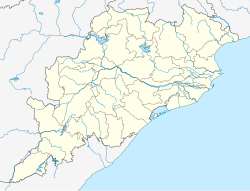User:Marcus334/Nalbana Bird Sanctuary | |
|---|---|
| Coordinates: 19°41′39″N 85°18′24″E / 19.69417°N 85.30667°E | |
| Country | |
| State | Orissa |
| District | Puri, Khurda and Ganjam |
| Area | |
• Total | 15.53 km2 (6.00 sq mi) |
| Elevation | 2 m (7 ft) |
| Languages | |
| • Official | Oriya |
| Time zone | UTC+5:30 (IST) |
| Website | www |
Nalbana Bird Sanctuary is a 15.53 km2 (6.0 sq mi) protected areacomprised mostly of Nalbana Island (in Oriya language, Nalbana means a weed covered island), a major island near the centre of Chilka Lake. It was notified in 1987 and declared a bird sanctuary in 1973 under the Wildlife Protection Act.[1]
The island gets completely submerged during the monsoon season. As the monsoon recedes in the winter, lake levels decrease and the island is gradually exposed. Migratory and resident birds then flock to the island in large numbers to feed. During 2007, nearly 840,000 birds visited the lake, out of which 198,000 were spotted at Nalbana Island. On Jan 5, 2008, a bird census involving 85 wildlife officials counted 900,000 birds of which 450,000 were sighted in Nalabana. Recent removal of invasive fresh water weeds from the lake is stated to be a contributing factor for the higher numbers of birds.[2]
Flora and Fauna
editLarge flocks of flamingos from Iran and the Rann of Kutch in Gujarat, feed in the shallow waters of the lagoon. Other long legged waders seen around Nalbana Island are the Lesser Flamingos, Grey herons, and Purple herons, Egrets, Spoonbills, Storks and White Ibis. Compact gregarious flocks of Brahminy Ducks, as well as Shovellers, Pintails, Gadwall, Teals, Pochards, Geese and Coots, are also seen.Raptors include the white-bellied sea eagle, osprey and peregrine falcon. [3]
Threatened birds reported in the lagoon are the rare migrant Spoon-billed Sandpiper, Asiatic Dowitchers also called the Snipebellied Godwit and the Goliath Heron.[3]
Long-legged waders, dabbling species, common raptor and Brahminy Kites, Pariah Kite(Black Kite), ducks, fish-eating birds and smaller Waders, Marsh harriers and Palla's Fishing Eaglesflock to the island. The endangered White-bellied Sea Eagle, the Kestrel and the globally threatened Peregrine Falcon are also seen. The nesting colonies of Gull-billed and River Terns were also seen on the Nalabana Island. The Bombay Natural History Society (BNHS) bird survey in 2002, recorded 540 nests of the Indian River Tern at the island, the largest nesting colony in the southeast Asia.[3]
Visitor information
editReferences
edit- ^ Orissa Forest Department. "CHILIKA (NALABANA)". Wildlife. orissaforest.org. pp. Sanctuaries. Retrieved 2008-12-21.
- ^ "900,000, Birds Visit Chilika Lake". srijanfoundation. Retrieved 2008-12-09.
- ^ a b c Chilika Development Authority (2008). "Avi fauna". Retrieved 2008-12-16.
- ^ Singh, Sarina (2005). India. Lonely Planet. p. 576. ISBN 1740596943, 9781740596947.
{{cite book}}: Check|isbn=value: invalid character (help); Unknown parameter|coauthors=ignored (|author=suggested) (help)
